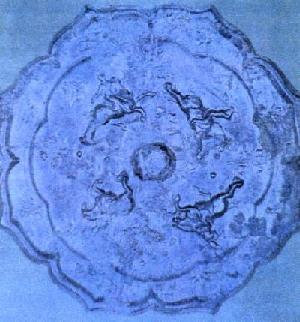The 300-year period in Chinese history from the Wei and Jin Dynasty(220-420) to the Southern and Northern Dynasty(386-581), witnessed great social turmoil and an intensive cultural amalgamation amongst various ethnic groups. The Sui Dynasty (581-618) unified China in 589, and Chinese acrobatics reached maturity, becoming a popular performing art with both the rulers and common people during the Tang Dynasty (618-907). Acrobats often performed with court singers and dancers in the royal palace.
|

|
| A Tang Dynasty bronze mirror decorated with patterns of female equestrians |
The Tang Dynasty was a period in Chinese history that witnessed marked economic and social progress, as well as the unprecedented prosperity of performing arts, including acrobatics and music and dance. Tang Dynasty scholars penned numerous poems to sing the praises of acrobatics, in addition to writing vivid accounts of acrobatic acts such as juggling swords and balls, rope climbing and pole balancing. Court performers during the Tang period featured many acrobatic actresses who were both beautiful and consummate in their arts.The Records of Things Seen and Heard by Master Fengdescribes rope tricks, stilt walking and human pyramids per formed in the royal palace. Movements from famous dances such asPrince Qin Breaks Through Enemy LinesandImperial Longevitywere often incorporated in acrobatic performances at that time.
Prince Qin Breaks Through Enemy Lines, a well-known dance during the Tang Dynasty, was choreographed by Emperor Taizong and performed by his ministers under his direction. The dance features a number of roaring war chariots followed by a battle formation of 120 armored warriors wielding weapons. The dance also features martial arts and horsemanship. Shi Huohu, a well-known acrobatic actress from Youzhou (in present-day Hebei Province), was quite likely from a minority ethnic group. Shi incorporated dance movements in her performance, including a movement in which she balanced a pole about 100 feet long on her head while five young girls clad in colorful costumes wielded weapons and danced like warriors inPrince Qin Breaks Through Enemy Lines.The young girls performed stunts on bowstrings attached to the pole to musical accompaniment.
Tang acrobats were highly skilled at pole tricks, including pole climbing and balancing poles on the head, as well as feats on poles erected on a chariot or held in the hand. The officials and noble lords of the Tang Dynasty on trips were often preceded by ceremonial processions consisting of singers, dancers, acrobats and artists performing pole tricks. Evidence of this can be find in the Tang mural entitledAn Outing by the Lady Songfound in the Dunhuang Grottoes in Gansu Province. High officials and noble lords not only used ceremonial processions to exhibit their power and wealth, but also to express their willingness to share the performances with common people.
